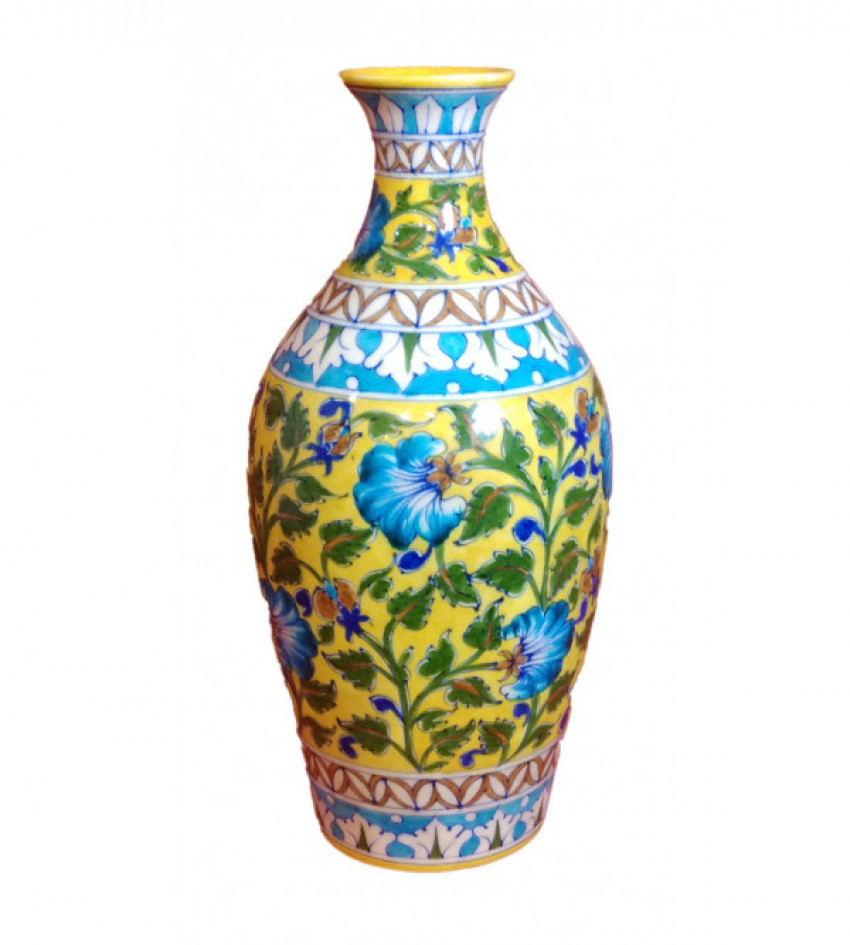
India is a country blessed with beautiful crafts, Khurja and Blue Pottery are some of them. Both pottery styles are unique in themselves hence it's important to know these interesting facts about each pottery.
Khurja Pottery
Fact 1: A traditional pottery style
Khurja is a conventional earthenware work did in India. It is situated in the Bulandshahr area in Uttar Pradesh, also known as 'the ceramic town'. It is popular for its pottery work made by utilizing material clay. It is a handicraft item that is high quality, handmade, and hand-painted.
Fact 2: 500 years old craft
Khurja pottery was still there when the Mughal emperor was ruling our country. Hence, it is not wrong to say that it is a 500-year-old craft.
Fact 3: Khurja pottery is full of benefits
Khurja pots enjoy different benefits its clay pots are useful for preparing food as keep up with the PH balance which makes the food less acidic and cook the food with less oil and holds all the nutrients.
Fact 4: Potters are known as Multani Kumars
The potters which make Khurja pottery are called Multani Kumhars. The reason behind that name is, it is said their origin was Multan. this creative pottery is a vocation for the quantity of artisian of Khurja.
Fact 5: Khurja pottery is produced on a large scale
At present, there are very nearly 500 factories in the city which produce Khurja work of art that is pots, jars, crockery, tiles, and other ceramic products. Further, the most famous institute of pottery work which is host in Khurja at present is Central Glass and Ceramic Research Institute.
Interesting facts about Blue Pottery
We as a whole love Blue Pottery and we as a whole realize Jaipur is the seat of this steadily developing blue ware industry. Whether it's pots, ash trays or vases or bowls or door knobs we as a whole have something or the other of this wonderful awesome technique. Here are a few facts about the Blue Pottery that relatively few of us know, however, couldn't imagine anything better than to:
Fact 1: Blue pottery originated from Turko-Persian
Do you also feel that Blue pottery is an Indian form of pottery? Wake up, man. It is Turko-Persian in origin! However presently a flourishing art form of art in different pieces of India, Blue Pottery follows its origins back to the Turkish and the Persians. It was the scheme of two civilizations because of which this workmanship showed up south to India. First were the Mongols who, as it is accepted, created this art form. They utilized Persian arts along with Chinese glazing techniques to make what we today call Blue Pottery. Then, at that point, the Mughals carried this craftsmanship alongside them when they attacked India.
Fact 2: Blue pottery is not CLAY pottery
It is the lone type of ceramics wherein 'CLAY' isn't utilized!
Nearly everybody relates earthenware to one, only a certain something – Clay! However, shockingly, Blue Pottery is a solitary type of ceramic that doesn't utilize clay as one of its fixings. Significant parts of the mixture are ground quartz stone, glass, Fuller's Earth (MulataniMitti), borax, and a couple of different synthetic substances. There are a bunch of mind-boggling measures associated with a creation that includes a ton of expertise.
Fact 3: Blue pottery combined with tile making
In its early stages, Blue Pottery was joined with tile making, as then, at that point rehearsed by the Mongols and the Turks. The tiles thus created were utilized inside the burial places, mosques, and different structures in Central Asia as a beautiful frill. Afterward, the Mughals began utilizing them in India, and gradually the procedure discovered spots in ceramics, done leftover simply a compositional frill.
Fact 4: Cobalt Oxide and Copper Oxide used in pottery
In its earliest stages, Blue Pottery was joined with tile making, as then, at that point rehearsed by the Mongols and the Turks. The tiles consequently delivered were utilized inside the burial places, mosques, and different structures in Central Asia as enhancing extras. Afterward, the Mughals began utilizing them in India and gradually the strategy discovered spots in ceramics, done leftover simply a design extra.
Finding an online website to shop? CCIC is where you will find everything.




